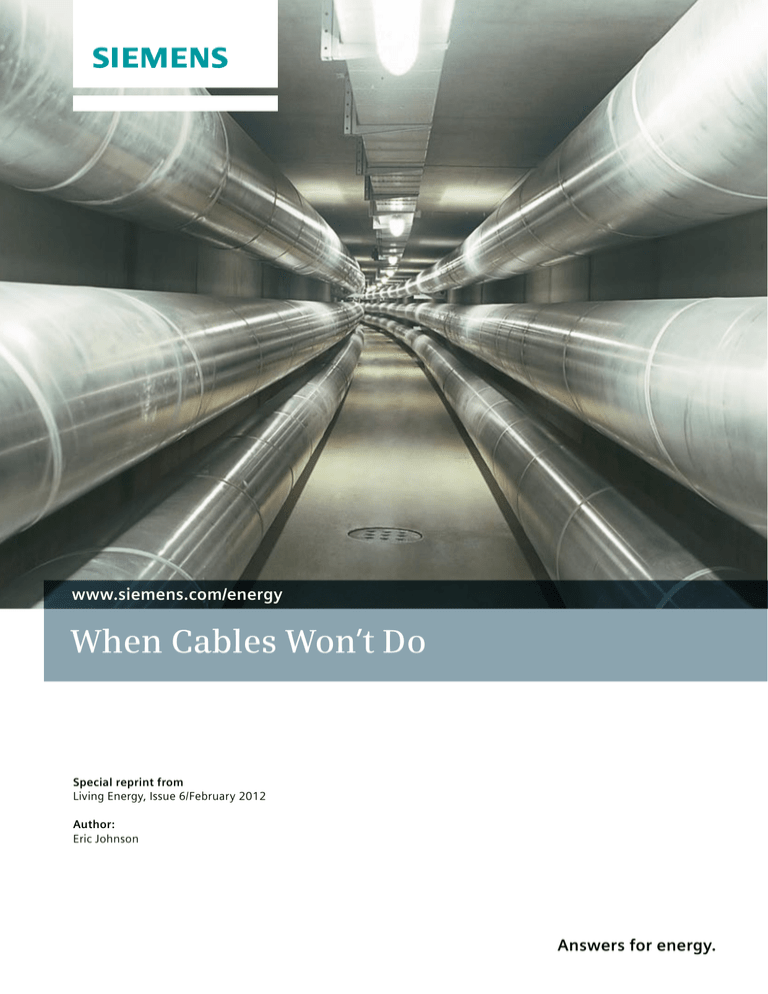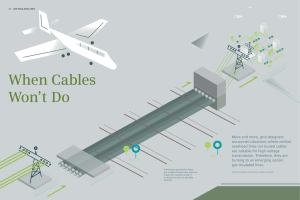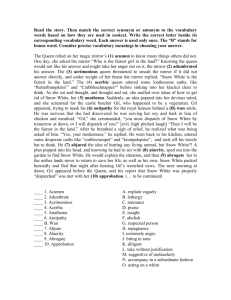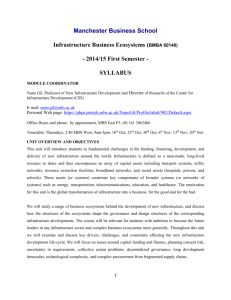
www.siemens.com/energy
When Cables Wonʼt Do
Special reprint from
Living Energy, Issue 6/February 2012
Author:
Eric Johnson
Answers for energy.
40
Gas-Insulated Lines
When Cables
Won’t Do
More and more, grid designers
­encounter situations where neither
overhead lines nor buried cables
are suitable for high-voltage
­transmission. Therefore, they are
turning to an emerging option:
gas-insulated lines.
Overhead transmission lines
are a safety hazard near airports.
A dual GIL system buried in
a ­narrow trench is a possible
­solution.
Text: Eric Johnson, Illustration: Leandro Castelao
42 Gas-Insulated Lines
Gas-Insulated Lines
­ omentum has grown steadily; half
M
of those structures have been commissioned over the last decade, and
more are on order.
Although GIL’s volume is not about
to threaten pylons’ iconic status nor
to replace underground cables wholesale, the technology clearly is on the
rise. To find out why, Living Energy
talked to Stephan Poehler, an expert
in GIL technology with the Siemens
Energy Sector. In short: GIL is clearly
a prime option for hydroplants, it
is often worth considering in other
crowded environments, and it can be
applied in four ways (see sidebar).
in a GIL that in the spring of 2011
went online at the international airport of Frankfurt, Germany. Carrying
a power load of two times 1,800 MVA
to a substation close to a new runway
was impossible with overhead lines,
because they would have posed a hazard to air traffic, so the choice came
down to a GIL or an underground cable.
GIL was selected because, among
­other reasons, its required trench is
about half the width of what a doubleunderground cable system would
need.
With lower-voltage systems, Poehler
notes, underground cables are usually
up to the job. However, in the 300- to
500-kV range, GIL starts to become
very competitive.
Tell Me Why
The advantages of GIL, as it turns out,
are myriad and often subtle.
■Nonflammability
■ Large
capacity
At a maximum, GILs can transmit up
to 3,700 MVA, but as Poehler points
out, this is truly the high end, requiring forced cooling to dissipate the heat.
A more typical load for a GIL is around
2,500 MVA.
This capacity competes easily with
that of a pyloned line (at two to three
times lower losses), and well exceeds
what a mono-underground cable system can offer. This was a critical factor
Illustrations: Leandro Castelao, independent
Pylons – these high-voltage highways
grid landscapes around the globe.
Marching across mountains, cutting
across prairies, their stiff, robot-like
figures guide massive loads of power
from one place to another. So ubiquitous as to be iconic, pylons are the
face to the public of the electricity
­industry.
Nonetheless, there are many places
pylons cannot go. And sometimes,
even their most common stand-in –
underground cables – are also problematic. Take, for example, the main
artery of a hydropower plant, the highvoltage line between the generating
cavern and the external switchgear.
Or the intra- and interconnections of
gas-insulated switchgear (GIS). Or,
for that matter, anywhere high-voltage
power must share confined space
with people and valuable equipment.
Siemens has a homegrown solution:
the gas-insulated transmission line
(GIL). Since its 1974 debut at a southwest German hydroplant (still ticking
along, without interruption), GIL has
gone on to become part of Siemensbuilt installations in 30 locations.
“Think of heating a pot full of water
in your kitchen,” Poehler muses. “Now
think of heating the same pot without
water.” The first analogy applies to
GIL and the second to conventional
cables insulated with XLPE (crosslinked polyethylene, a plastic compound). The massive metal content in
GILs absorbs much more heat than
an XLPE line, allowing it to maintain
lower operating temperatures, even
in overload mode. Thanks again to its
massive, robust construction, a GIL
is also much less prone to internal-arc
faults and short circuits, and like overhead lines, it is amenable to automatic reclosure.
Nonflammability was among the
key considerations in several recent
hydropower installations. In Kaprun,
Austria, for instance, a 150-meter GIL
system is in action, and a 650-meter
line consisting of 13 kilometers of GIL
tubes is being built in China’s Sichuan
Province. In both cases, power is
piped from the generators deep down
in the mountain up to the top, where
the pylons pass it on to end users.
­Using a nonflammable GIL rather
than a conventional cable that could
catch fire has two major design benefits: The tunnel no longer requires
fire barriers, which block convection
and therefore make cooling more
Living Energy · Issue 6/February 2012
Apps for Downloading Power
GILs are not new, but an attractive alternative to conventional cables, though
unlikely to replace them. GILs come in four different application types:
Aboveground
GILs are largely unaffected by extreme
conditions. Particularly high transmission power can be achieved with
aboveground installation.
Tunnel
GIL systems installed in a tunnel remain
accessible for inspection. They pose no
fire risk and allow the tunnel to be used
for ventilation purposes at the same time.
Vertical
GILs can run at any gradient, even
vertically, making them attractive in
cavern hydropower plants.
Direct burial
Lines wrapped with polyethylene
to safeguard the enclosure, and land
above can be restored to agricultural
use. Buried systems are expected to
last over 40 years.
43
Gas-Insulated Lines
■ Flexibility in routing
Due to their unique properties, GIL
systems are now used worldwide
wherever difficult transmission tasks
require complex routings. They have
been installed in every conceivable
layout, with shafts covering straight
vertical inclines of 200 meters over
steep slopes, passing around buildings,
including subterranean structures,
and smoothly following serpentine
routings without being joined
at ­angles.
Distances of up to about 70 kilometers
are possible, Poehler says, without
any compensation of reactive power.
XLPE cables, by contrast, would need
reactive compensation about eight
times higher along that same stretch.
Not only does this add cost to the line,
but compensation is notorious for
causing ambient noise – and irritating
neighbors – from its air cooling. Furthermore, it causes operational losses,
which are also a significant factor to
be taken into consideration.
At the same time, Poehler cautions
against overblown expectations that
GIL might become the main future
form of high-voltage transport. Massive load shifts, foreseen for new,
­remote generating areas such as the
southwestern USA (solar and wind)
or the North Sea (wind and perhaps
tidal/wave), will be carried mostly by
pylons. “In sensitive areas, GIL may
be used instead,” he notes, “but the
workhorse will be overhead lines.”
Photos: Siemens
GIL can traverse steep inclines (above: Limberg power plant, Austria) or pass underground (below: Kelsterbach
near Frankfurt Airport, Germany, before refilling the trench.)
Living Energy · Issue 6/February 2012
■ Direct link to GIS
Like father, like son: GIL technology
was born out of GIS (gas-insulated
switchgear), and their ongoing relatedness makes them natural partners.
They have similar or identical characteristics in terms of transmission
power, overload capacity, automatic
reclosure, and other technical factors,
making joins easier, cheaper, and
usually smaller in volume.
Living Energy · Issue 6/February 2012
■ Lowest
electromagnetic field
With its “line in a can” design that
neutralizes inductive current, a GIL
generates electromagnetic fields
15 – 20 times lower than conventional
cables, even meeting upper limits as
low as 1 μT. So it can easily be used
where there is sensitivity to such radiation: hospitals, air-traffic control
centers, or computer clusters. Or exhibition halls: The Palexpo in Geneva,
Switzerland, installed a 500-meter,
300-kV GIL in 2001 that allowed a new
exhibition hall to be built directly
above the transmission line (a few meters below ground) without any disturbance of the sensitive exhibited
equipment.
■ Lack
of aging
Unlike XLPE, which can degrade with
usage, the gas in GIL does not age.
So performance does not degrade over
time. Because it operates at lower
temperatures than conventional cables, the GIL is also subject to less
thermal stress.
So Which Is It?
It is impossible to say precisely which
feature is most important. The weighting of reasons, Poehler says, varies
from one customer to the next. “And
GIL won’t be for everybody,” he adds.
“But it’s a transmission technology
that is going to grow and grow.” Not
into a replacement for the pylon, but
enough so that decision makers really
need to know about it. ■
Eric Johnson writes about technology,
­business, and the environment from Zurich.
­Formerly, he headed what is now a Thomson
Reuters bureau and corresponded for
­McGraw-Hill World News.
GIL Specifications
■ Max
transmission capacity per system:
■ Max
voltage: up to
3,700 MVA
550 kV
■ Max
transmission distance without compensation of reactive power: up to 70 km
■ Performance
remains constant over
time; no aging
■ Fireproof
■ High
overload capacity
■ High
short-circuit withstand capacity
■ Autoreclosure
■ Lowest
30
Magnetic lux density B [μT]
­ ifficult, and accessibility and staff
d
safety are guaranteed at all times during operation.
45
25
functionality
electromagnetic field
Cable
Overhead
line
20
15
10
5
GIL
0
A comparison of the magnetic fields
for different high-voltage transmission systems for a 400-kV double
system at 2 x 1,000 MVA load.
More information about GIL can be
found in this book by Siemens engineer
Hermann Koch, commissioned by the
Institute of Electrical and Electronics
Engineers (IEEE):
Further Information
www.siemens.com/energy/hv-gil
H. Koch: GIL –
Gas-Insulated
Transmission
Lines (Wiley,
2011).
Published by and copyright © 2012:
Siemens AG
Energy Sector
Freyeslebenstrasse 1
91058 Erlangen, Germany
Siemens AG
Energy Sector
Power Transmission Division
High Voltage Substations
Freyeslebenstrasse 1
91058 Erlangen, Germany
www.siemens.com/energy/hv-substations
For more information, please contact
our Customer Support Center.
Phone: +49 180/524 70 00
Fax: +49 180/524 24 71
(Charges depending on provider)
E-mail:support.energy@siemens.com
Power Transmission Division
Order No. E50001-G620-A146-X-4A00 | Printed in Germany |
Dispo 30000 | c4bs No. 7463 |
TH 250-120250 | WÜ | 472771 | SD | 03123.0
Printed on elementary chlorine-free bleached paper.
All rights reserved.
Trademarks mentioned in this document are
the property of Siemens AG, its affiliates,
or their respective owners.
Subject to change without prior notice.
The information in this document contains
general descriptions of the technical options
available, which may not apply in all cases.
The required technical options should therefore
be specified in the contract.






